Introduction:
Mini-split systems, whether heat pumps or cooling-only units, efficiently regulate indoor temperature by both heating and cooling. However, they invariably generate condensation during the cooling process. As the indoor units extract humidity from the air, condensation builds up, necessitating a proper drainage system. Understanding how much condensation your mini-split produces, often contingent on the unit size (e.g., a 9,000 BTU unit yielding ~0.8 pints per hour), is vital.
This article aims to elucidate the diverse options available for managing condensation, contingent upon the style of your indoor unit and the installation method chosen.
High Wall Mounted Indoor Units:
When installing the indoor unit on an exterior wall, a hose usually extends from the unit, typically ranging from 12 to 18 inches. For exterior wall installations, a flexible 5/8" drain hose can be connected to the unit's drain hose, leading the condensate to the ground or a gutter. Concealing this hose with a line-set cover enhances aesthetics. Alternatively, hard PVC can be used to direct condensate downwards, ensuring it moves away from the house's foundation by employing a 45-degree angle at the end of the run.
For interior wall installations, the line-set can run within or outside the wall. Adequate slope directing condensate to an exterior wall or drain eliminates the need for a pump. In cases lacking sufficient slope, a condensate pump becomes essential, often necessitating a transition to a thin clear vinyl tubing for efficient evacuation.
Ceiling Cassettes and Slim Horizontal Ducted Units:
Cassettes and attic units commonly require hard PVC for condensate evacuation. They are typically equipped with built-in condensate lift pumps, assisting in elevating the condensate line to facilitate natural slope towards the exterior or a drain.
Multi-Position (Traditional) Air Handlers:
For these air handlers, utilizing hard PVC is usually sufficient. The condensate line can be directed to a sump pump or the exterior. If neither option is viable, a pump facilitating evacuation becomes necessary, ensuring it aligns with the pump's specifications to prevent overworking.
Additional Recommendations for Units Distant from Exterior or Code-Compliant Drains:
Units situated far from exterior walls or code-compliant drains require strategic thinking. Exploring chases, bulkheads, closets, or unused spaces to run lines to the basement or an unfinished space can be beneficial. Avoiding the use of a pump, if possible, by finding alternative routes might warrant extra effort but can be worthwhile in the long run.
Conclusion:
Condensate management is a crucial aspect to consider during mini-split installations. A well-executed condensate drainage strategy ensures uninterrupted unit operation, preventing frequent shutdowns due to blockages or debris buildup. Ultimately, a meticulously planned condensate management system can save considerable time and money, averting potential water damage issues. Choosing the appropriate method aligned with your unit type and installation location ensures efficient and hassle-free operation of your mini-split system.













